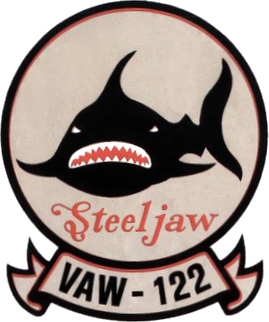
Carrier Airborne Early Warning Squadron 122 (VAW-122) was an aviation unit of the United States Navy in service from 1 September 1967 to 31 March 1996. Originally nicknamed the "Hummer Gators" and later as "Steeljaws" was a U.S. Atlantic Coast Carrier Airborne Early Warning Squadron stationed at NAS Norfolk. During its 30 years of existence, the squadron was deployed around the world and saw action from Vietnam to Desert Storm, conducting operations from the Arctic to the tropics.

Carrier Airborne Early Warning Squadron 121 (VAW-121), also known as the "Bluetails", is an Airborne Early Warning (AEW) and Command and control (C2) squadron of the United States Navy, operating the E-2D Hawkeye. Established in 1967, the squadron is based at NAS Norfolk. It is currently assigned to Carrier Air Wing 7 and deploys aboard the aircraft carrier USS George H.W. Bush.
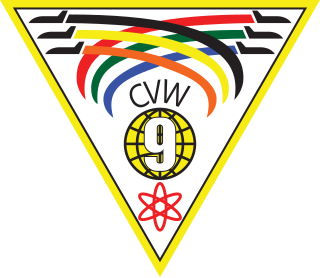
Carrier Air Wing Nine (CVW-9) is a United States Navy aircraft carrier air wing based at Naval Air Station Lemoore. The Air Wing is currently assigned to the aircraft carrier USS Abraham Lincoln (CVN-72). The Tail Code of aircraft assigned to CVW-9 is NG.

Strike Fighter Squadron 2 (VFA-2) also known as the "Bounty Hunters" is a United States Navy F/A-18F Super Hornet strike fighter squadron based at Naval Air Station Lemoore, California. Their tail code is NE and their callsign is "Bullet". They are attached to Carrier Air Wing 2 (CVW-2), a composite unit made up of a wide array of aircraft performing a variety of combat and support missions that deploy aboard the Carl Vinson.
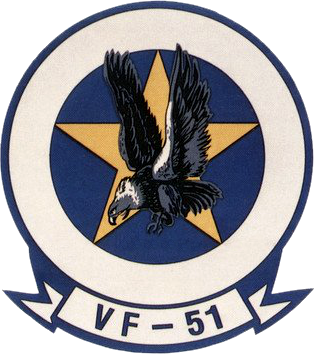
VF-51, Fighter Squadron 51 was an aviation unit of the United States Navy known as the "Screaming Eagles". It was originally established as VF-1 on 1 February 1943, redesignated as VF-5 on 15 July 1943, redesignated as VF-5A on 15 November 1946, redesignated VF-51 on 16 August 1948, and disestablished in March 1995. Until its disestablishment, VF-51 was the oldest fighter squadron in continuous service with the Pacific Fleet.

Fighter Squadron 114 (VF-114) was a fighter squadron of the United States Navy that was active from 1945 through 1993. Nicknamed the "Aardvarks", it was based out of Naval Air Station Miramar, California. The squadron flew combat missions during the Korean War and Vietnam War. VF-114 was disestablished as part of the post-Cold War drawdown of forces on 30 April 1993.

Strike Fighter Squadron 154 (VFA-154), also known as the "Black Knights", is a United States Navy strike fighter squadron stationed at Naval Air Station Lemoore. The Black Knights are an operational fleet squadron flying the F/A-18F Super Hornet. They are currently attached to Carrier Air Wing Eleven and deployed aboard the aircraft carrier USS Theodore Roosevelt. Their tailcode is NH and their callsign is "Knight".

Strike Fighter Squadron 105 (VFA-105) also known as the "Gunslingers" is a United States Navy strike fighter squadron based at Naval Air Station Oceana, Virginia. The "Gunslingers" are an operational fleet squadron and fly the F/A-18E Super Hornet. Their radio callsign is "Canyon" and the tail code is AC.

Airborne Command and Control Squadron 123 (VAW-123) is based at Naval Station Norfolk, flying the E-2C Hawkeye. They are attached to Carrier Air Wing Three (CVW-3) while deployed aboard USS Dwight D. Eisenhower. The squadron nickname is the Screwtops.

Airborne Command & Control Squadron 116 (VAW-116) is a US Navy Command and Control Squadron that deploys aboard USS Nimitz as part of Carrier Air Wing Seventeen, flying the E-2C Hawkeye 2000 aircraft. VAW-116 is stationed at Naval Base Ventura County under the cognizance of Commander, Airborne Command Control and Logistics Wing (COMACCLOGWING). The current commanding officer is Commander Phillip J. Sheridan.

Airborne Command & Control Squadron 117 (VAW-117) is an airborne early warning (AEW) and command and control (C2) squadron. Nicknamed "The Wallbangers,” it flies the E-2D Hawkeye, the only carrier-capable command and control aircraft. The squadron is based in NAS Point Mugu and deploys as part of Carrier Air Wing 9 (CVW-9) on board USS Abraham Lincoln.
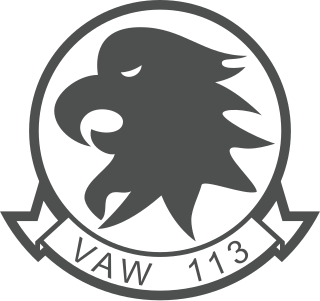
Airborne Command & Control Squadron 113 (VAW-113), known as "Black Eagles", was established on 20 April 1967 flying the E-2A Hawkeye.

Airborne Command & Control Squadron 125 (VAW-125), known as the "Torch Bearers" or "Tigertails", was established on 1 October 1968, at Naval Air Station Norfolk. The squadron's initial supporting command was Carrier Air Wing Three (CVW-3) deploying aboard USS Saratoga.

Airborne Command and Control Squadron 115 (VAW-115), also known as the "Liberty Bells", is a United States Navy airborne early warning and control squadron that flies the E-2D Advanced Hawkeye. All VAW-squadrons were originally since 1948.
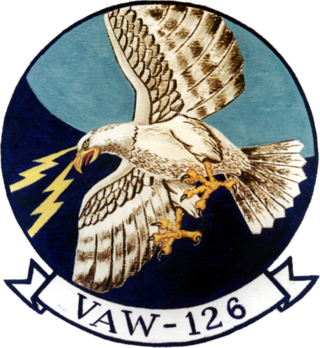
Carrier Airborne Early Warning Squadron 126 (VAW-126), nicknamed the "Seahawks", is a carrier airborne early warning squadron of the United States Navy. The squadron is based at NS Norfolk, equipped with five E-2D Hawkeye aircraft.

Carrier Airborne Early Warning Squadron 112 (VAW-112) is an inactive United States Navy squadron. It was nicknamed the "Golden Hawks". VAW-112 flew the E-2C Hawkeye out of NAS Point Mugu and last deployed in 2013 as part of Carrier Air Wing 9 (CVW-9) on board USS John C. Stennis.

Airborne Command & Control Squadron 124 (VAW-124) "Bear Aces" is a United States Navy airborne early warning and control squadron based at Naval Air Station Norfolk, Norfolk, Virginia. It flies the Northrop Grumman E-2D Hawkeye and is currently attached to Carrier Air Wing 8 (CVW-8).

VA-52 was an Attack Squadron of the U.S. Navy. It was established as U.S. Navy Reserve Fighter Squadron VF-884 on 1 November 1949, and called to active duty on 20 July 1950. It was redesignated VF-144 on 4 February 1953, and VA-52 on 23 February 1959. The squadron was nicknamed the Bitter Birds from about 1951–1953, and the Knightriders from about 1960 onward. Its insignia evolved through several versions and variations from 1951 to the 1980s. VA-52 was decommissioned on 31 March 1995.

Fighter Squadron 1 (VF-1) was a fighter squadron of the United States Navy. Originally established on 14 October 1972 it was disestablished on 30 September 1993. It was the fifth US Navy squadron to be designated VF-1. Known as the "Wolfpack" the squadron saw combat during the Vietnam War and Operation Desert Storm. The squadron was de-activated and its personnel reassigned in 1993 when its carrier, USS Ranger, was decommissioned.

Fighter Squadron 111 (VF-111), also known as the Sundowners, was a fighter squadron of the United States Navy. Originally established as Attack Squadron 156 (VA-156) on 4 June 1955, it was redesignated VF-111 on 20 January 1959, the day after the original VF-111 was disestablished. The squadron was redesignated VF-26 on 1 September 1964, redesignated as VF-111 on 17 September 1964 and disestablished on 31 March 1995.






















